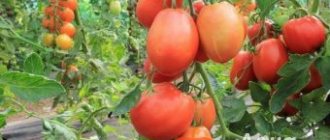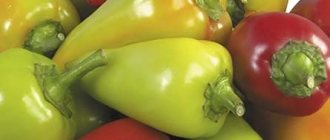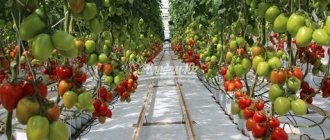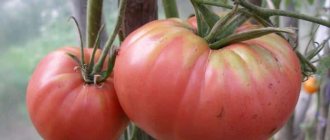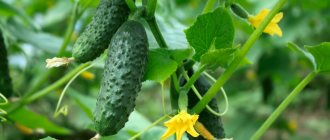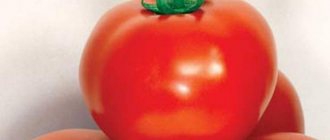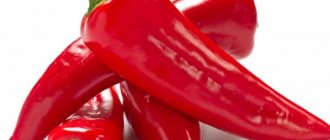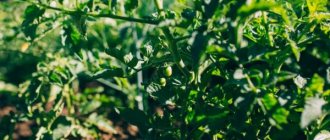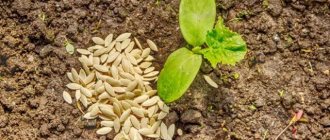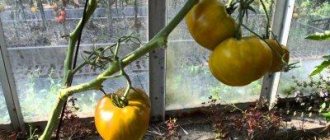Cucumber Mazai F1 enjoys the well-deserved love of gardeners. It is endowed with all the qualities for which hybrids are valued: rapid ripening, excellent yield, the ability to set fruit without pollination by bees and, of course, excellent taste. The fruits are genetically devoid of bitter taste, juicy and aromatic.
| Landing location | Ripening time | Mode of application | Fruit length | Group | Fruit smoothness | Pollination method |
| Universal | Early ripening (35-45 days) | Universal | Medium - from 10 to 15 cm | Hybrid | Slightly lumpy | Parthenocarpic |
Description of the variety
The Mazai cucumber is an early ripening cucumber. It is one of the best in this category. It has a parthenocarpic type of pollination.
It is better to grow it not on large plots, but in small farms and small garden plots; the variety also has the following features:
- Included in the State Register of the Russian Federation for the third light zone precisely because of what was said in the previous sentence. This variety was discovered by Borisov A.V. and Krylov O.N.
- Cucumber has medium-branched plants with two ovaries. Moreover, they are located in every node.
- Zelentsy are approximately 10-14 cm in length. But from time to time there are specimens smaller or larger than this figure. And this is also quite normal. If you cut them transversely, they turn out to be triangular.
- Female type of flowering or predominantly female. The harvest is formed approximately one and a half months after the first shoots.
- The average yield of the variety is from 12 to even 15 kg per square meter. This is a very high figure.
Productivity
The marketable yield in the spring-summer period is approximately 6.7 kg of greens per 1 m2. The early yield indicator reaches 3.2 kg per 1 m2. Both indicators significantly exceed the yield level of the standard varieties “Virenta” and “Legend”.
Which regions are best to grow in?
The hybrid "Mazai" is approved for cultivation in the third light zone.
For growing in spring-summer rotation, the use of film shelters is recommended. In the south, cultivation in open beds is allowed.
Characteristics of the variety
It is recommended to grow in greenhouse structures and tunnels. If a gardener lives in a region where the weather is predominantly warm (for example, in the south of the country), you can simply sow and plant it calmly in beds, in open ground, the variety has the following characteristics:
- The shape of the fruit is leveled, cylindrical. There are large tubercles on their surface. Zelenets, as the name suggests, is green.
- The weight of greens is approximately 100-122 grams. But again, there are specimens both larger and smaller than the specified norm.
- Excellent taste, including when pickled. Can also be consumed fresh. It is much healthier this way, it contains more vitamins. There is no bitterness or voids in the pulp.
Mazai cucumbers have many advantages and almost no disadvantages. For example, they are very resistant to most cucumber diseases.
One of them is that the marketable output indicators are a very high indicator of marketable output. It is equal to 98%.
Mazai cucumbers can be called super ripe, with an early and friendly harvest. It is important that a considerable number of greens are poured at the same time.
It is recommended to grow in spring and summer, preferably under film covers.
List of advantages and disadvantages
The list of advantages of a hybrid includes:
- Early fruit formation.
- Simultaneous ripening of a large number of fruits.
- Taste that meets high consumer requirements.
- Universal use of the resulting crop.
- Cucumber resists many dangerous diseases.
- If planting rules are followed, the vegetable ripens on unprotected soil and in a greenhouse.
- Limited branching facilitates the formation of a bush.
List of negative characteristics:
- seeds prepared from their own fruits are unproductive;
- commercial yield is inferior to some hybrid varieties.
Growing
The recommended planting density in greenhouses is 2.5 plants/1 m2. In open ground, this figure is from 3 to 5 plants/1 m2.
Have you always observed the norm for seedling planting density?
Not really
A vegetable crop like cucumbers in general, and this variety in particular, is very demanding of heat. Good air humidity, and also, naturally, soil, is also an important indicator.
It should be placed on fertile, humus-rich soils. The following planting rules should be observed:
- You should prepare for landing very much in advance. In the fall you need to prepare the soil, and in the spring you need to level it, first loosening it.
- If planting through seedlings is chosen, then they need to be planted; they need to be planted when they are 3 weeks old. This should be approximately May 5-10. They need to be planted in two rows. The distance between them is about 0.5 meters. The gap between the holes for planting is about 35 cm.
- Compliance with crop rotation rules is also very important. Cucumbers should not be planted in beds after pumpkin crops have previously been planted there.
- Preparation of beds for planting should begin after the soil has warmed up to sufficiently positive average daily temperatures for a sufficiently long time. That is, at a soil temperature of at least 15 or even 20 degrees. Of course, with a plus sign.
- To plant cucumbers, it is advisable to prepare beds in advance. Their height should be 20-25 cm. A layer of organic matter is laid out on top. And on the upper layer (it is about 10 cm) a layer of fertile soil is applied. Of course, sufficiently moisturized. It is advisable to fertilize the planting holes or furrows before planting.
- Shoots will appear in about a week if the cucumbers are properly cared for.
Photo, video, description, planting, characteristics, yield, reviews of the cucumber hybrid “Mazai F1”
Choosing cucumber varieties for future planting is necessary taking into account many characteristics: ripening time, cultivation conditions, yield. Also, you should not lose sight of another important criterion, the form of pollination. Hybrid cucumber “Mazai” is considered one of the fastest ripening parthenocarpic varieties.
Origin of the cucumber variety “Mazai F1”
Specialists (Mytishchi) worked on the creation of the early ripening cucumber hybrid “Mazai”. Since 1998, it has been officially registered in the state register of breeding achievements of Russia for garden plots, household plots and small farms. Authorship belongs to A.V. Borisov, I.N. Krylov, E.A. Orekhova.
Description of the variety
Short review:
A characteristic feature of the Mazai hybrid is its early ripening. Fully matures in 42-46 days after the emergence of full shoots.
Fruit:
- They have a cylindrical shape, without a neck;
- Green in color, with smeared stripes that cover up to 13-12 lengths of the greens;
- With a peel covered with sparsely located large tubercles;
- Length - from 10 to 13 cm;
- Average weight - from 100 to 120 grams.
Description:
Bushes:
- Indeterminate type, can reach a height of 3.5 to 4.5 meters;
- With average formation of green mass, climbing, have limited branching;
- With female or predominantly female type of flowering;
- The leaves are large in size, smooth, slightly dissected, entire, pentagonal-rounded in shape, green in color;
- With a tuberculate, cylindrical ovary, with complex, sparse, white pubescence;
- Each leaf node forms 1-2 ovaries.
Advantages and disadvantages
Hybrid "Mazai" has the following advantages:
- Early ripening;
- High productivity;
- Intensive filling of ovaries;
- Short fruit;
- Complex immunity to diseases;
- Good resistance to adverse conditions;
- Zelentsy has a universal purpose;
- Excellent taste characteristics;
- High pickling qualities;
- The yield of marketable products is not less than 98%.
Application
Cucumbers taste good both fresh and canned. Zelentsy is pickled in barrels and preserved in jars.
Agricultural technology or proper cultivation: sowing seeds for seedlings, picking
The cucumber hybrid “Mazai” places increased demands on heat, as well as good soil and air humidity. To grow the crop, it is worth using fertile, loose and humus-rich soils. Basic recommendations for proper cultivation:
- In the fall, the soil is cultivated and fertilizers are applied, and in the spring the bed is loosened and leveled;
- A prerequisite is compliance with crop rotation. It is not recommended to grow cucumbers where pumpkin vegetables previously grew;
- As soon as the soil warms up to a depth of 10-12 cm and consistently warm weather sets in, they begin to prepare the beds for planting;
- The beds are made 20-25 cm high. An organic layer is laid on top and sprinkled with a 10-centimeter layer of abundantly moistened fertile soil;
- The optimal temperature for germination is from +20 to +25 degrees. After a week, the first shoots will appear;
- Upon reaching the age of 21 days, the seedlings are transplanted in the first ten days of May to a permanent place. When planting, a two-row method is used with an interval of 50-60 cm. The distance between planting holes is maintained from 30 to 35 cm;
- In greenhouse structures, the recommended planting density is no more than 2-3 cucumber bushes per 1 m2.
How to properly care for the Mazai hybrid:
- During the period when fruits are formed en masse, watering is of particular importance. But even at the beginning of the growing season, the cucumber crop needs watering every two days, spending at least 7-8 liters of water per m2. Water under the bush with warm, settled water;
- When grown in unprotected soil during periods of prolonged rainfall, the risk of rapid spread of various rots increases. That is why you should not allow cucumber vines to become thick and thin out the plants in time;
- Cucumbers need systematic feeding. It is allowed to use ready-made mixtures that are intended for pumpkin crops, or an infused solution of manure;
- In order for the root system to grow and develop properly, it needs air. By loosening the soil, air exchange can be improved. The procedure is of particular importance after irrigation and precipitation;
- Weeding is always carried out simultaneously with loosening.
Diseases and pests
The Mazai hybrid boasts excellent immunity to diseases. It is not afraid of cladosporiosis, common cucumber mosaic, downy mildew and root rot.
Productivity
The marketable yield in the spring-summer period is approximately 6.7 kg of greens per 1 m 2. The early yield indicator reaches 3.2 kg per 1 m2. Both indicators significantly exceed the yield level of the standard varieties “Virenta” and “Legend”.
Which regions are best to grow in?
For growing in spring-summer rotation, the use of film shelters is recommended. In the south, cultivation in open beds is allowed.
Reviews about the variety from those who planted
The hybrid cucumber “Mazai” was highly appreciated by gardeners and speaks extremely positively about it. The early ripening period allows gardeners to get an early harvest of greens not only when grown in greenhouses and greenhouse structures, but also in open beds in unprotected soil.
Partecarpy makes the Mazai hybrid suitable for growing in greenhouses.
Care
Cucumbers of any variety, and “Mazai” in particular, love moisture. Therefore, it is necessary to water them regularly. Moreover, with warm water and preferably at the end of the day. In addition, by watering the plants with cold water, you can “play out” until the cucumber roots become hypothermic.
Once every 10 days you need to feed the plants. Fertilizer options: peat substrate, manure humus, etc.
Expert opinion
Filatov Ivan Yurievich, private farmer for more than 30 years
It is imperative to rid cucumbers of various weeds. In order to get a rich harvest, you can combine weeding with loosening. You can also loosen after rain and add soil.
Cucumber variety RMT F1
RMT F1 – was developed by Russian breeders in laboratories at the Mars agricultural company. You can find the variety in the Ural Summer Resident series. It can be cultivated in a greenhouse or in beds. Ripening is early, from seed pecking to fruiting it should take 36-44 days.
Description of the plant
Flowering type: parthenocarpic. The ovary is formed in bunches. The bushes are weakly leafy, the vines reach up to 2 m in length. Up to 5 cucumbers are tied simultaneously under one leaf knot. The leaf blades are rich green with a rough surface. The plant must be formed into one stem.
Important!
Collect cucumbers daily to prevent the plant from stopping fruiting. The peculiarity of the variety is that the vegetable crop will not begin to set new fruits while the ripe ones are on the bushes.
The fruits grow in the shape of an elongated cylinder. The length of the greens is 11-13 cm, and the weight is 80-100 g. The skin is colored unevenly green, at the end it is light green, closer to the “tail” it is rich green. The surface is finely tuberculate, the spines are white. The pulp is without bitterness, with a pleasant sweetness and rich cucumber aroma. Cucumbers are intended for canning and fresh consumption. The originators claim that from 1 m² of plantings over the entire growing season the yield is 35-40 kg.
The hybrid culture is immune to downy and powdery mildew, and root rot. The plant is resistant to long periods of drought and heat. During drought, fruiting decreases, but as soon as the water balance of the cucumbers returns to normal, everything returns to normal. It is moderately resistant to low temperatures and unfavorable conditions.
Advantages and disadvantages
RMT F1 is an ideal variety for summer residents and large farmlands.
| Advantages | Flaws |
| Good fruit yield | The need for fertilizing |
| Weather conditions have little effect on growth and fruiting | The area where cucumbers grow should be sunny and draft-free |
| High commercial quality of greens | |
| Zelentsy form and ripen in a short period of time |
Agricultural technology and care
The originators recommend planting cucumbers in a greenhouse in March, and in open beds in the second half of May. The optimal temperature for growth is +20-25°C. Place no more than 4 plants per 1 m². It is advisable to water with warm, settled water. Feed the vegetable crop at least 4 times during the growing season. The hybrid responds well to fertilization with a mullein-based solution.
Reviews
Vegetable growers liked the Rmt F1 variety for its high yield and tasty fruits. The disadvantage for many was the price of the seeds. For a pack of 10 seeds you will have to pay up to 100 rubles. It is not profitable for beginning farmers to buy them in large quantities. Caring for plants is simple, the main thing is to feed them on time.
Diseases and pests
The most effective remedy for any variety of cucumbers is wood ash. You can spray and dust absolutely all plants with it. Not only cucumbers and not only the Mazai variety.
In total, you need to do at least 6 feedings per season. And at least one of them:
- extract from wood ash and mullein infusion;
- use calcined salt;
- spray the leaves from the underside with infusion of potassium permanganate (3 g per 10 l).
This, by the way, is an excellent prevention against powdery mildew. By the way, the variety in question has immunity to this disease. Exactly the same as for the cucumber mosaic virus and olive spot. The variety has no immunity to all other diseases. The same goes for pests.
Cucumber “Mazai f1”: a popular parthenocarpic gherkin-type hybrid
The early ripe cucumber “Mazai f1” belongs to the hybrid group and is characterized by a parthenocarpic type of pollination. Included in the State Register of the Russian Federation for the third light zone. The originators of this popular and sought-after variety were A.V. Borisov and O.N. Krylov. The hybrid is intended for cultivation in garden plots, as well as in household and small farms.
Description of the variety
An early-ripening parthenocarpic hybrid of the gherkin type “Mazai f1” has medium-branched plants with two ovaries at each node. The plant has a female flowering type, the harvest is formed one and a half months after germination.
Zelentsy are 10-14 cm long, round-triangular in cross section. The fruits have a flattened cylindrical shape. The surface of the greenery has sparse and superficial large tubercles. The mass of greens is 100-122 g. The pulp is without voids and bitterness.
Advantages and disadvantages
Cucumber "Mazai f1" is recommended for growing in greenhouses and greenhouse structures, as well as tunnels. In the southern regions, gardeners sow it in open ground beds. This hybrid form has many advantages and is almost completely free of disadvantages. The main, most important advantages include the following:
- super-early ripening hybrid with early harvest formation;
- friendly and massive harvest yield;
- female or predominantly female type of flowering;
- the vegetative and reproductive abilities of this variety are very high;
- simultaneous pouring of a large number of greens;
- lumpy, white-thorned, medium-pubescent greens are very attractive;
- high taste and pickling qualities;
- yield of commercial products is not less than 98%;
- resistance to olive spot and PTO;
- The variety is tolerant to LMR and is practically not susceptible to root rot.
The branching of the plant is small, which facilitates the process of caring for cucumber bushes and speeds up harvesting. Commercial yield indicators in spring-summer turnover reach about 6.7-6.9 kg/sq.m. m.
How to plant cucumbers (video)
Landing rules
A vegetable crop such as the hybrid cucumber “Mazai f1” requires heat, as well as good soil and air humidity. Such a plant should be placed on fertile, loose and humus-rich soils. Further landing rules are as follows:
- in the autumn the soil is tilled and fertilized, and in the spring the soil should be loosened and leveled;
- it is very important to observe crop rotation and not plant cucumbers in beds after pumpkin vegetable crops;
- after heating the soil to a depth of 10-12 cm and sufficient positive average daily temperatures, the beds are prepared for planting;
- ridges 20-25 cm high are prepared, a layer of organic matter is laid on top of them and 10 cm of richly moistened fertile soil is poured;
- at the optimal temperature for germination, which is +20-25 °C, mass shoots appear in about a week;
- Seedlings at the age of three weeks should be planted on May 5-10 in two rows with a distance of 0.5-0.6 m and a gap between planting holes of 30-35 cm.
The standard planting density of cucumbers in beds in greenhouses is 2-3 plants per square meter. When growing this hybrid form on ridges in open ground - 3-5 plants.
Growing technology
The “Mazai-f1” cucumber at all stages of its development requires competent agrotechnical measures:
- During the period of mass formation of fruits, watering is especially important, but even at the very beginning of the growing season, cucumbers require water once every two days, with a flow rate of at least 7-8 liters per square meter of cucumber plantings.
- When cultivating cucumbers in open ground conditions during the long rainy season, the risk of rapid spread of rot increases sharply, so it is very important to prevent thickening of the cucumber vines and to thin out the plants in a timely manner.
- Cucumbers need systematic feeding, which can be prepared mixtures intended for pumpkin crops or an infused solution of manure.
- For proper growth and development of plants, the root system requires air, so loosening the soil should be done to improve soil aeration. It is especially important to do this after watering and rain.
- Weeding cucumber beds is also always combined with loosening.
Reviews about the variety
The “Mazai f1” cucumber, despite its relative novelty, has earned very positive reviews and high marks from gardeners. Due to the fact that “Mazai” is a hybrid form of early ripening, vegetable growers have an excellent opportunity to get the earliest harvest not only in greenhouses and hothouses, but also in open ground beds.
Cucumbers are small and slightly pubescent, and the average yield, even in unfavorable years, does not fall below 12-15 kg per square meter. The taste is wonderful, the pulp does not contain bitterness, there are no voids inside. A very healthy variety, especially if the cucumbers are consumed fresh. The seeds of this variety of cucumbers arouse keen interest among vegetable growers and are purchased by them very actively.
How to care for cucumbers (video)
Photo
If you are one of those people for whom text is not enough, and who does not mind illustrating the words of the article with photographs, we are ready to help you:
Cucumber variety Taganay F1
The originator of the hybrid is the Russian company Ural Summer Resident. Breeders were able to cross different varieties without resorting to gene modification. The variety can be cultivated in any region of the Russian Federation. Ripening period is early. The first fruits appear 37-39 days after the first leaf appears.
Description of the plant
The bushes are strongly climbing, the main stem grows slowly. A large number of female-type ovaries are formed on the side shoots, which guarantees high productivity. The plants are parthenocarpic, so there is no need to worry about flower pollination. The leaves are green with light green veins, medium in size, heart-shaped. The leaves are attached to the shoots by a long petiole. Up to 3 cucumbers are formed in one node.
Zelentsy grow cylindrical, leveled. The length of ripe fruits does not exceed 10 cm and 105 g. The skin is dark green with white stripes at the end. Large tubercles with small white spines can be traced across the entire surface of the fruit. The pulp is dense, without bitterness, and is not prone to the formation of voids. The yield per 1 m² is 11-12 kg. Universal use. Fruiting is friendly.
Important!
It is necessary to remove fruits once every two days.
The gene set of the plant will protect against common fungal and viral diseases. The vegetable crop easily tolerates drought and prolonged rains. The fruits of the plant are not prone to rotting. The marketable qualities of vegetables are preserved for up to 10 days after harvesting from the garden. During transportation they do not lose their appearance or taste.
Advantages and disadvantages
Taganay is included in the list of the best hybrid varieties of Russian selection.
| Advantages | Flaws |
| Shows immunity to diseases, endurance to heat, prolonged rains | Seeds do not retain parental qualities |
| Parthenocarpicity | |
| Short fruit formation | |
| High commercial quality of greens |
Agricultural technology and care
Plants love space. The beds cannot be thickened. Plant no more than three bushes per 1 m². In greenhouse conditions, it can be planted throughout the year. In the garden beds, the originators recommend sowing cucumbers throughout May. Plants like soil with a neutral pH. Before flowering appears, it is advisable to water the vegetable crop with warm water.
Reviews
The Taganay variety has become a favorite of hundreds of thousands of gardeners throughout Russia, thanks to its high fruit yield and plant endurance. Grows in any conditions. To increase yields, gardeners advise increasing the frequency of fertilizing.
